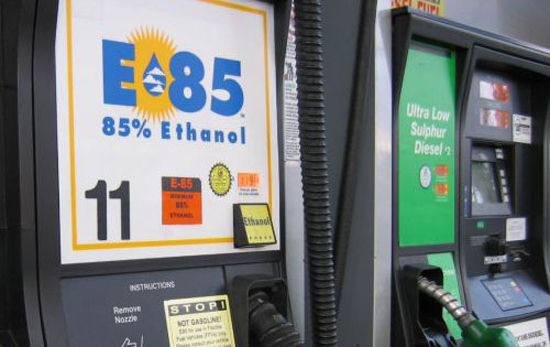EPA Gives Final Approval for E15 Blend
Tim Esterdahl | Jul 03, 2012 | Comments 7
The Environmental Protection Agency has given its final approval for 15-percent ethanol blends for sale at all consumer gas stations nationwide effective immediately. Sounds like good news for flex-fuel drivers, yet there are still some roadblocks and industry criticism.

While E85 has been out for a while, the EPA has given its final approval to E15.
Since the introduction of the Ethanol blend fuel, it has been under scrutiny as to the potential benefits and downsides. This scrutiny has meant that the EPA has taken its time giving its final approval for blend. According to Consumer Reports, “First, the agency approved the fuel for use in 2007 and newer cars and trucks in 2010. Then in January 2011, it expanded the approval to all vehicles made since 2001. Last July the agency devised a label that would be required on pumps selling E15, so consumers who drive older cars would be able to tell the difference. In April, EPA approved the production of E15.”
Many organizations have opposed the final approval and sale of the E15 citing a variety of issues including consumer confusion and engine durability. Plus there is some question to how useful the fuel is. It is true that it can help reduce oil consumption by blending in gas yet it doesn’t improve gas mileage. Rather the pump fueling savings are a wash compared with the lower fuel economy. And there are still local and state regulations that are holding back the full implementation of the ethanol blend.
There is also some criticism about how the government can give energy credits to manufactures who build flex-fuel vehicles when they don’t necessarily help the environment nor reduce oil usage.
Consumer Reports says:
While E15 could be an effective way to reduce petroleum consumption on a national basis, blending additional quantities beyond E10 poses compatibility hurdles with both infrastructure and vehicles. As a liquid fuel that has been produced for centuries, ethanol should require the fewest changes from traditional petroleum of any available alternative.
What do you think? Should we even bother spending time on Ethanol fuel?
Related Posts:
Filed Under: Auto News


What does one do if their owner’s manual says “E10 or less”, that is do not use fuel with more than 10% Etanol?
Will E10 still be available?
LJC – By law, all vehicles built for sale in the USA can run E15 since the 2001 model year. In practice, most vehicles can run E15 without any trouble…it’s not a big deal, even on the oldest motors.
That’s good to know. However, I checked my 2011 Tundra’s owner’s manual and Toyota reccommends no more than 10%. I wonder why the law and Toyota’s reccomendation are not in sync.
Here’s another question: are the HP and TQ ratings different for E10 and E15? Just curious.
It is a big deal! You will rarely find any performance vehicle that will run on this crap. Ethanol is miscible with water. Meaning it is water loving. Is attracted to and will mix with water. Thats a great idea right. Because all cars run great on gas/ water / ethanol mix right.? Effects Lesspower, significantly reduced lifespan, anything rubber, or plastic will be at high risk. Ethanol leaves a crusty film on engine parts when set over time. Higher egts, Etc etc etc… In the long run the consumer will be paying more for fuel. Due to the significatly reduced fuel effiency.
Cater – All good points, but I think the dangers of E15 are a bit over-stated. Water contamination, for example, is relatively rare. Damage to rubber gaskets and seals is a concern, but most newer vehicles (I think everything built after 2004?) has seals and gaskets that are rated for E15. Finally, newer engines have special coatings on the pistons, inside the cylinders, etc. that protect against damage that might be caused by formic acid (the most dangerous by-product of ethanol combustion).
I’m not arguing with you of course, just pointing out that newer vehicles are more than capable of running E15 without problems.
I tried E85 on chevy silverado’s and my current tundra and both do NOT like running it at all. More ethanol is for sure a bad thing as others have mentioned and for good reason. It wears engines components out much quicker since why do you think if using E85 50% or more then toyota requires to change oil at 2500 miles and not 5000 miles?
Yet another stupid idiotic govt. proposal passed that doesn’t make sense. We need to fire them all and get a whole new govt. in place.
mk – That 2500 mile interval has been touted for a few years now, but the recommendation makes no sense. I think dealers are pushing this to increase the amount of work they can do. See this post: https://www.tundraheadquarters.com/blog/2009/06/29/oil-changes-running-e-85/